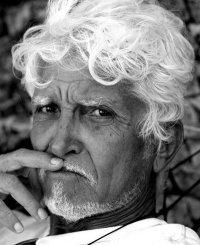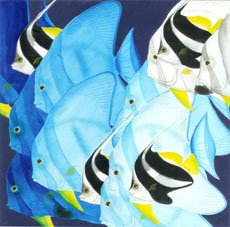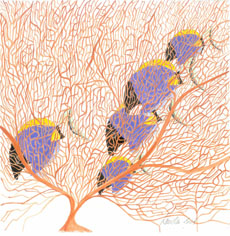His locks of white hair and casual dressing – shorts, sandals, shirt – make 68 year-old Philippe Laurella, a distinct figure on the streets of Male.
His many years in the Maldives, have earned him a spot in folklore, and most Maldivians know him as the white guy who married a Maldivian and settled here.
“When I first came to Maldives there was a certain charm to Maldives,” says Philippe.
In May 1978, the country was as different as it could be from his native France. There was no electricity, no telephone, no television, but Philippe says “life was nice, contact with Maldivians was good, and back then they didn’t have the same preoccupations as now.”
Arriving in Maldives
Philippe left France in 1978 in a vehicle called the ‘magic bus’ with no plans to visit the Maldives.
“I had vaguely heard of the Maldives back then, but most people used to confuse it with some islands located near Argentina.”
A keen traveler, he spent time in Amsterdam, Greece, Afghanistan, Iran and Pakistan before ending up in India where he met a French couple. “They said: ‘Why not come with us to Maldives?’”
His plan to stay for 15 days ended as 18 months: “I was struck by the beauty and the simplicity of the place,” he says.
Procuring a boat in Noonu Atoll Velidhoo, the place he would later call home, he built a deck and a cabin and set sail to see Maldives, travelling from Haa Alifu to Laamu.
At the end of his voyage, Philippe continued on and toured India, Sri Lanka, Burma and Singapore before returning to France. Barely a month later was he back in Velidho: “I kept thinking about this country.”

Philippe designed his first safari boat, ‘Baraabaru,’ which “was the start of tourism in the country. Most safari boats didn’t have cabins back then.”
He takes pride in the fact that Velidhoo is now famous for safari boats, and most islanders own one.
A printer by profession, Philippe learnt the art of building boats and incorporated his own ideas. With a Maldivian crew, he set about organizing safari trips. Sailing for six months a year, he took the rest of the six month off in Velidhoo. He even designed and built his house, complete with thatched roof.
One day a crew member pointed to his wife’s sister, and asked Philippe, “shall we arrange something?”
In true Maldivian style, within a month Philippe married Fathimath Adam.
“She said yes and her family said yes,” he says, smiling. He was so accustomed to the Maldivian way of life he didn’t find it strange. “I did like her, and we fell in love. We spent 25 years together and had three kids.”
Problems occurred the first year as Philippe’s smattering of Dhivehi words was the only way they could communicate. Food also was a problem as he disliked hikimas (dry fish).
“Kirugarudhiya (a type of curry) with hikimas and cold rice is the worst,” he said.
Fathimath proved to be a great cook and with the limited resources available made simple and delicious meals, he says.
Sadly, she passed away in 2005 after falling ill with kidney failure. The entire family moved to Male in 2003 from their peaceful existence in Velidhoo to be with her during her treatment.

Painting and living in modern Maldives
Despite coming from a family of artists – Philippe’s mother is a painter as his older brother, while the younger one is a musician and writer and his sister a classical dancer – Philippe was never interested in painting. However boredom on a rainy day in Male in 1999 led him to try, and when a Swiss friend liked and bought his work it became the catalyst for becoming a painter.
His paintings are mostly of fish; a swirl of tiny blue fish, giving a peek into orange fishes that are passing behind. Or one of his most recognisable paintings: the long legs of a stork and its head peering back into the painting amid multi-colored fishes swimming by. The colours are striking; the paintings uplift your spirits, while showcasing the beauty of fishes.
He stays true to his first medium, watercolour. His paintings were exhibited in Esjehi Gallery in 2000 as well as two years ago in an exhibition held by Association Franco-Maldivienne.
“Youngsters often stop me on the street and ask me if I could teach them painting,” he says. His lack of formal training makes him hesitate, though he is not averse to the idea.
“It’s not easy for a painter in Male to be inspired and to come up with ideas,” he muses.
Most painters paint in rooms in their houses; there are no studios which limits the process of imagination. He would love to diversify and paint aspects of island life, “but most of my clients want fish paintings.”
Philippe sells his paintings mostly to tourists, with a few rich Maldivians also part of his clientele. He feels the art scene in Maldives still needs to develop, and says he likes painters like Eagan who have produced some exceptional paintings of Maldivian life.
As for his life here, “I’m not sure I would stay if I arrived to Maldives now.”
Modernity is a double edged sword, he says.

“Before you could go fishing and nobody could get in touch with you, now mobile phones are a necessity everywhere.”
Even landing in Velidhoo was subject to nature, as they had to wait for high tide to get the boat close to the island: “Life was complicated, but still there was charm and serenity.”
He laughingly recounts how when initially Maizan Adam Manik spoke to him about Pyrard De Laval, the famous French navigator, he ended up thinking Pyrard was in Male. “I asked him: how can I meet him, and Adam Manik said you can’t, he lived here 300 years ago.”
He has seen three presidents rule the country, and is now fluent in Dhivehi.
“My stay here just happened. This could be a 32 year stopover – I could still continue my voyage.”